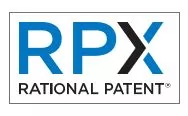In Q1 2020, NPEs and operating companies both filed significantly more patent litigation than in first quarters past, with NPEs in particular having their busiest Q1 since 2015. Defendants, meanwhile, faced the impact of judicial decisions throughout the quarter that further constrained their ability to challenge patent validity.
Of those defensive tools, arguably most affected was the Patent Trial and Appeal Board. In March, the Federal Circuit declined to revisit its October decision in Arthrex, opening the floodgates to the rehearing of numerous America Invents Act review decisions—potentially affecting more than 200 cases, according to an RPX analysis. Other appellate rulings during Q1 imposed further substantive and procedural constraints on both petitioners and the Board itself. Additionally, the Supreme Court left Section 101 caselaw in its post-Berkheimer narrowed state by declining to review that decision, though it also rejected a number of challenges against Alice itself in Q1. Statements by lawmakers, moreover, cast doubt on the viability of legislative Section 101 reform.
In contrast, the Federal Circuit's February decision on venue in In re: Google brought greater certainty for companies with significant reliance on Internet infrastructure, ruling that the presence of a defendant's servers within third-party facilities does not establish venue. The opinion overturned a controversial Texas ruling that might have effectively "reestablished nationwide venue", at least according to one of the appeals court's circuit judges.
Finally, another factor affecting market dynamics has been the ever-increasing popularity of litigation finance, which drove a number of significant new assertion campaigns in the first quarter and has set the stage for additional litigation from established and up-and-coming plaintiffs alike. Fears of an economic downturn due to the COVID-19 pandemic may further fuel this trend, as uncorrelated assets like litigation finance have already proven popular among secondary investors seeking "recession-proof assets". The ongoing divestiture of patents from Intellectual Ventures LLC (IV) has also remained a consistent catalyst for NPE activity; to that end, throughout the first quarter, RPX noted several such entities stockpiling divested IV assets in preparation for their likely assertion.
- Litigation Update: Q1 Outpaces Prior Quarters, with NPEs Seeing the Biggest Upward Trend
- Venue Update: West Texas Continues to Rise, While the Federal Circuit Closes an East Texas Loophole
- PTAB Update: Filings Hold Steady in Q1 as Arthrex Continues to Cast Doubt on Prior Decisions
- Patent Eligibility Update: Berkheimer Is Here to Stay, While Legislative Reform Efforts May Have Stalled
- Marketplace Update: Litigation Finance-Backed NPEs Continue to Rise, and More IV Divestitures Hit the Market
Litigation Update: Q1 Outpaces Prior Quarters, with NPEs Seeing the Biggest Upward Trend
RPX data show that 926 defendants were added to patent litigation campaigns in the first quarter of 2020, an increase of 18.6% as compared to the first quarter of 2019 and slightly higher than the average for 2016-2019. Sequentially, the overall defendant count was down 11.6% compared to Q4 2019, consistent with seasonality patterns observed in past years.
| Defendants Added | Change Compared to: | ||||
| Q1 2020 | Q1 2019 | Q1 2016-2019 Average | Q4 2019 | ||
| Operating Company | 421 | +20.6% | -7.6% | -20.6% | |
| NPE | 505 | +16.9% | +13.8% | -2.3% | |
| Total | 926 | +18.6% | +3.0% | -11.6% | |
Operating Company Plaintiffs
Litigation filed by operating companies in the first quarter outpaced the same period last year, with 421 defendants added—20.6% higher than Q1 2019. Still, filings by operating companies in the first quarter of 2020 were down 7.6% compared to the Q1 average for 2016-2019. Notably, the Q1 tally in 2020 was boosted by cases asserting design patents, including a single campaign against dozens of online retailers. Excluding cases asserting only design patents, litigation by operating companies was roughly flat as compared to the first quarter of 2019.
NPE Plaintiffs
NPE filings in Q1 2020 were the highest observed in any first quarter since 2015.
For their part, NPEs added 505 defendants to litigation campaigns in Q1, 16.9% higher than the corresponding quarter in 2019 and 13.8% higher than the four-year average for the first quarters of 2016-2019.
Defendants Added to Litigation Campaigns by Quarter
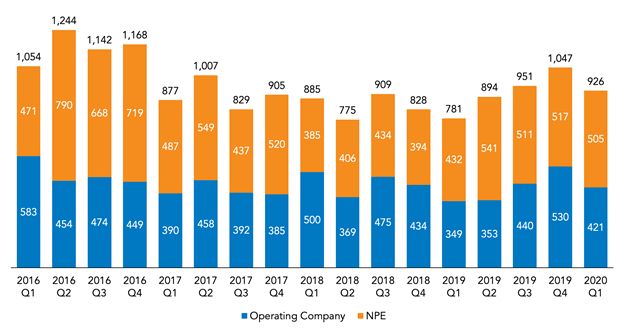
Note: More defendants were added by operating companies in Q4 2019 than were previously reported due to a single case filed under seal in November 2019 that was not unsealed until January 22. That lone case, filed by Doggie Dental against numerous individuals and entities alleged to have sold counterfeit toothbrushes for dogs, added more than 130 defendants to the prior total.
The Procedural Impact of COVID-19
It is not yet clear what impact COVID-19 will have on the filing of new patent litigation, but certain restrictive measures introduced by courts in response to the pandemic have already begun causing delays for some litigants. Notably, some popular patent venues have cancelled or continued trials scheduled in the next few weeks, including the District of Delaware (which has vacated all trial dates scheduled through April 30), the Northern District of California (May 1), the Central District of California (April 13), the Eastern District of Texas (May 1), and the Western District of Texas (May 1).
Those venues diverge somewhat on their treatment of other matters. For instance, the Northern District of California has decreed that all civil matters shall be decided on the papers, with necessary hearings conducted remotely, while the Central District will not hold any hearings except for those on emergency matters (temporary restraining orders and preliminary injunctions), which will also be remote. Both districts have closed most courthouses and limited access to those facilities. In contrast, the District of Delaware and the Eastern District of Texas have given their judges discretion over whether to continue holding hearings, bench trials, conferences, and other proceedings (although they have recommended that they be conducted remotely). In the latter district, this has led to some inconsistent treatment of emergency requests for relief such as continuances.
Venue Update: West Texas Continues to Rise, While the Federal Circuit Closes an East Texas Loophole
In the first quarter of 2020, the District of Delaware remained the most popular district for patent litigation overall but fell to second place for both NPE and operating company cases. The Western District of Texas became the second-most popular district overall in Q1, up from the number-three spot in Q4 2019, while it held the top spot for NPE litigation in the first quarter. West Texas has also jumped into the top five for operating company suits, overtaking the Eastern District of Texas for fifth place in Q1.
Top Patent Litigation Districts in Q1 2020 by Defendants Added
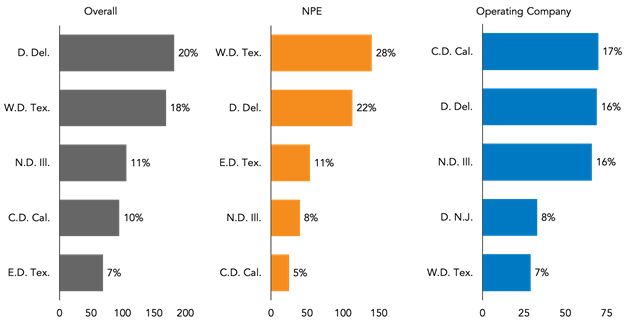
Q1 also brought some much-needed clarity with respect to a lingering district court split over venue. While the Supreme Court's 2017 decision in TC Heartland restored a narrower reading of the patent venue statute's first prong, holding that a corporation "resides" for venue purposes in its state of incorporation and curtailing forum-shopping as a result, some courts have since broadly interpreted the second prong, under which venue is proper in part where a defendant "has a regular and established place of business". This began in 2018, when District Judge Rodney Gilstrap of the Eastern District of Texas held in Seven Networks v. Google that certain Google servers maintained in an ISP data center each constituted a "regular and established place of business".
What followed were two years of inconsistent district court rulings on similar facts and a debate over the severity of the issue within the Federal Circuit, which initially declined to address the issue in response to a Google mandamus petition. Circuit Judge Jimmie Reyna, dissenting from that decision not to weigh in, warned that leaving Gilstrap's rule in place could "reestablish nationwide venue" for many companies "by standing for the proposition that owning and controlling computer hardware involved in some aspect of company business (e.g., transmitting data) alone is sufficient". Companies took those concerns to heart, with some even going to far as to move certain equipment out of the Eastern District of Texas to reduce their exposure in that venue.
The Federal Circuit finally took up the issue the second time around in another lawsuit against Google, resolving the split in its February In re: Google decision. The court ruled that the "regular, physical presence of an employee or other agent of the defendant conducting the defendant's business" is required "at the alleged 'place of business'", though it clarified that it was not deciding two issues raised by the plaintiff in that litigation: whether a machine could serve as an agent and the related question of whether a machine can accept service. Those issues have since been raised by another NPE, Personalized Media Communications, LLC, which has argued that similarly located Google servers qualify as agents under the Federal Circuit's holding. Google and campaign codefendant Netflix have pushed back on this reading, countering that machines presently lack the capacity to "consent" to act on behalf of a principal.
PTAB Update: Filings Held Steady in Q1 as Arthrex Continues to Cast Doubt on Prior Decisions
In the first quarter of 2020, 341 petitions for America Invents Act (AIA) review were filed with the Patent Trial and Appeal Board (PTAB), including 317 petitions for inter partes review (IPR), four petitions for covered business method (CBM) review, and 20 petitions for post-grant review (PGR). Overall, the number of AIA review petitions filed in Q1 was slightly higher than in Q4 2019 (which saw 332 petitions filed), with Q1 2020 coming in just over the number of petitions seen in Q1 2019 (340).
AIA Review Petitions Filed by Quarter
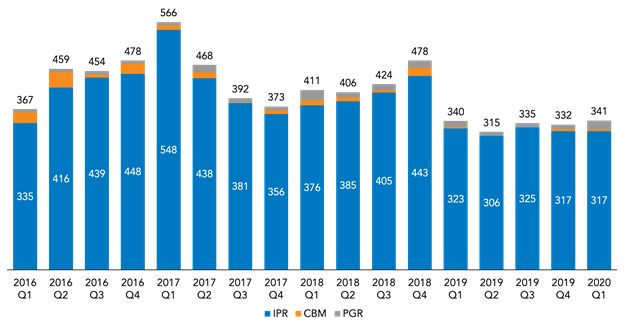
COVID-19 and the PTAB
As with district court litigation, it is not yet clear how the filing of petitions for AIA review will be affected over the long term by the COVID-19 pandemic. With respect to ongoing proceedings, while the PTAB will not automatically extend deadlines, it has been granted authority under the CARES Act (the COVID-19 relief bill recently signed into law) to grant 30-day extensions for due dates falling on March 27 through April 30 for AIA review requests for rehearing, petitions to the chief judge, and preliminary responses and related responsive filings. The PTAB may also delay institution decisions as a result of those extensions. Requests for extensions must affirm that the delay sought is COVID-19-related.
The Federal Circuit Upholds Arthrex
While new PTAB filings have started to level out, following a year-over-year decline in 2019, existing proceedings have faced uncertainty as a result of the Federal Circuit's October decision in Arthrex, which held that the appointment of PTAB administrative patent judges (APJs) is unconstitutional. In that opinion, the court concluded that the APJs, as appointed under the existing statutory regime, were "principal officers" requiring Senate confirmation under the Constitution's Appointments Clause, based in part on the finding that the USPTO director lacked sufficient discretion over removing them from service. As a result, the Federal Circuit opted to resolve the constitutionality issue by severing the statute limiting that removal authority in order to render the APJs inferior officers. The US government and both parties subsequently sought a rehearing, with the government arguing that another case would be a better vehicle for the constitutional issue, one side arguing that the Arthrex panel went too far, and the other insisting that it did not go far enough.
The Federal Circuit declined to rehear Arthrex on March 23, and has since rejected calls by the US government and both parties to stay the issuance of its mandate. While appellant Arthrex has indicated that it will seek Supreme Court review, with the US government suggesting that it may as well, parties are now free to pursue rehearings within the purview of Arthrex's holding. The impact could be sweeping, as an RPX analysis indicates that more than 200 AIA reviews may be subject to remand and rehearing—affecting over 50 litigation campaigns in which the patents challenged in those reviews have been asserted.
No More "Same-Party Joinder": The Federal Circuit's Windy City Decision
Another first-quarter Federal Circuit decision ended a longstanding "safety valve" employed by companies subject to parallel district court litigation. In cases where defendants did not learn of the specific claims against them until past the one-year statutory time bar—after which it would no longer be possible to file an IPR targeting the asserted claims—those defendants were previously able to file an initial IPR in the first year challenging some claims from the patent-in-suit and then another once they learned what the actual asserted claims were, seeking joinder to the first petition. In its March 18 decision in Facebook v. Windy City Innovations, the Federal Circuit eliminated that strategy, holding that the clear and unambiguous language of the governing statute—35 USC Section 315(c)—does not authorize the Board to "join" an entity to an IPR proceeding in which it is already a party ("same-party joinder") or to "join" new issues "material to patentability, such as new claims or new grounds" to an existing IPR. The decision may significantly increase leverage for NPEs that hold larger patent portfolios with many claims, as it may now be less practical for some defendants to challenge those assets before the PTAB.
The Federal Circuit's Prisua Decision: No IPR Cancellation of Indefinite Claims
The Federal Circuit also reined in the PTAB in its February 4 decision in Samsung v. Prisua Engineering, addressing a decision in which the Board—faced with a claim challenged in an IPR and concluding that it could not determine the claim's scope—ruled that the claim was invalid as indefinite under Section 112. Rejecting arguments that the PTAB may sidestep statutory limitations restricting petitioners to Sections 102 and 103 to cancel claims as indefinite on its own accord, the Federal Circuit ruled that the Board lacks such power.
Patent Eligibility Update: Berkheimer Is Here to Stay, While Legislative Reform Efforts May Have Stalled
The Federal Circuit's February 2018 opinions in Berkheimer and Aatrix have significantly curtailed the application of Alice as a defensive tool, preventing the early resolution of eligibility disputes when plaintiffs raise material factual disputes over a patent's inventiveness. Now, just over two years later, the result of those two decisions has been a significant drop in patent invalidation rates. Through Q1, 44% of patents challenged under Alice that have seen rulings since Berkheimer have had claims invalidated, whereas 67% of the patents adjudicated before Berkheimer saw the invalidation of claims (excluding the small number of decisions per patent with mixed-by-claim outcomes).
Patents Invalidated Under Alice Before and After Berkheimer
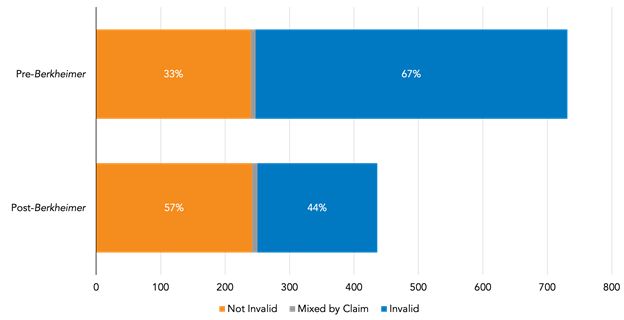
Note: Some percentages add up to more than 100%, as patent claims occasionally see multiple Alice rulings with different outcomes. (For example, a claim may be found not invalid in one case and invalid in another.)
Ongoing shifts in the venue distribution of patent suits may accelerate this trend as judges more inclined to expansively apply Berkheimer and Aatrix see more patent cases—a notable example being District Judge Alan D. Albright of the Western District of Texas, which (as mentioned above) was the favored district for NPEs in the first quarter. Judge Albright has signaled a deeply skeptical posture toward early Alice motions; in an order issued in January 2020, he declined to revisit his prior denial of a Rule 12 eligibility challenge based on several factors. These included the presumption of validity, which in Judge Albright's view makes a Rule 12 motion "a procedurally awkward place for a court resolve a patent's § 101 eligibility"; the general notion that it is "generally wise" and "more efficient" for a court to delay a Section 101 determination until after issuing a Markman order; the likely need for fact discovery to resolve an Alice motion; and the overall difficulty of applying the Alice test consistently, arguing that delaying an Alice determination to gain a better understanding of a patent and its underlying technology makes it more likely the court will make the "correct" 101 ruling.
Breaking the data down by procedural stage shows that Alice challenges decided at Rule 12 and summary judgment have both been seen a marked drop in invalidation rates, falling well below 50%: since Berkheimer, 44% of patents have had claims invalidated at Rule 12, compared to roughly 70% before; and just 38% for summary judgments issued post-Berkheimer, versus 58% previously.
Patents Invalidated Under Alice Before and After Berkheimer by Procedural Stage
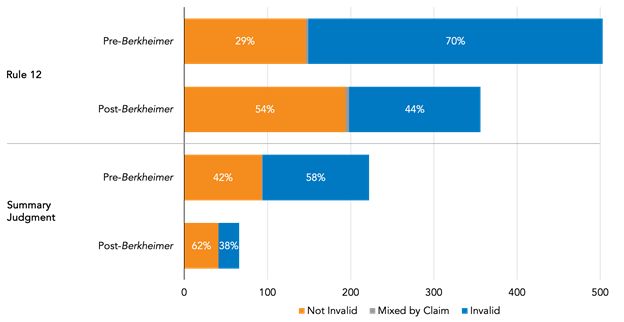
RPX data further indicate that plaintiffs are much less successful when trying to preclude an Alice ruling at the Rule 12 stage than at summary judgment. For decisions that turned on Berkheimer/Aatrix, where a plaintiff asserted that a factual issue precluded early resolution and the court's order actually addressed that issue, courts found sufficient facts to issue a ruling 54% of the time for Rule 12, or 81 of the 150 patents challenged at that stage. Of those decisions, the ensuing decision on the merits resulted in the invalidation of claims for all but two challenged patents.
In contrast, for summary judgment decisions turning on Berkheimer/Aatrix, courts found that they had sufficient facts to move forward just 30% of the time (or just eight patents out of 27). However, all eight of those patents saw claims invalidated.
Patents with Alice Orders Addressing Berkheimer by Procedural Stage
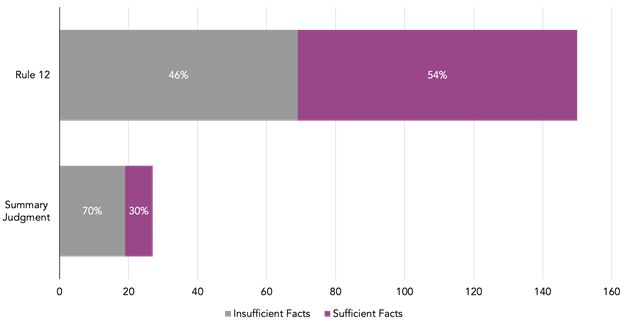
Breaking the data down by plaintiff type further reveals that NPEs are less successful than operating companies at blocking Rule 12 challenges under Berkheimer/Aatrix, with courts finding sufficient facts to issue a ruling 62% of the time for motions against NPEs but 46% of the time for those against operating companies. NPEs fare even worse at the summary judgment stage, as courts found sufficient facts to rule in 75% of Alice summary judgment motions against NPEs—whereas for summary judgment motions against operating companies, courts found sufficient facts just 11% of the time.
Patents with Alice Orders Addressing Berkheimer by Procedural Stage and Plaintiff Type
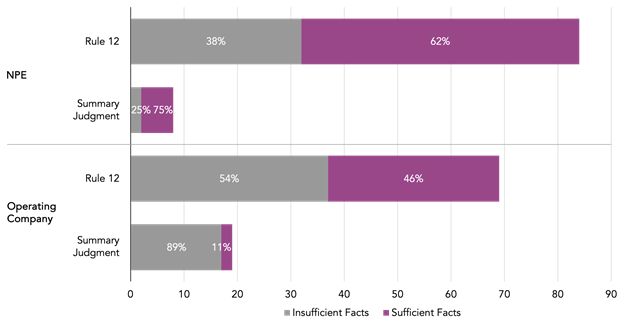
Overall, since the Alice decision's issuance in June 2014 and through the end of Q1 2020, 60% of patents have seen claims invalidated under its rationale. Outcomes diverge based on plaintiff type; while operating company patents have an Alice invalidation rate of 50% during that period, around 66% of NPE patents saw claims invalidated.
Patents Invalidated Under Alice Since the Decision's Issuance
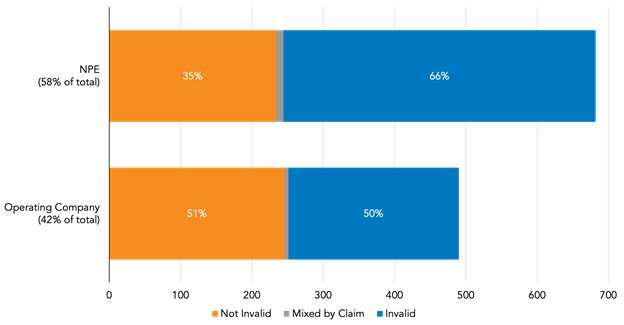
The Supreme Court Declines to Review Berkheimer and Alice
On January 13, the Supreme Court denied HP's certiorari petition seeking to overturn Berkheimer, all but ensuring that it is here to stay—leaving Alice in its current, narrower form.
Throughout the first quarter, the Supreme Court also declined a number of other petitions challenging the Alice test itself. These included one appeal denied on January 27, Trading Technologies v. IBG, after the US Solicitor General filed an amicus brief on behalf of the US government opposing the grant of certiorari, arguing that the case was "not a suitable vehicle" for addressing broader issues with Section 101. Other denied petitions attacking the Alice test included ChargePoint v. Semaconnect (also denied on January 27), Cisco Systems v. SRI International (denied February 24), and Morris Reese v. Sprint Nextel.
Reform Legislation: Conflicting Signals from Congress on Bill's Progress
Stakeholders hoping that Congress will step in received conflicting signals from the legislature during the first quarter, despite progress toward a bill in the Senate in 2019. Last May, Senators Chris Coons (D-DE) and Thom Tillis (R-NC), the chairmen of the Senate IP Subcommittee, introduced a draft bill that, among other changes, would eliminate all judicially created patentability exceptions, thereby abrogating cases like Alice and Mayo, and that would codify the presumption of eligibility as to Section 101. After receiving heated pushback at a series of hearings on the bill that June, Senators Coons and Tillis promised to release another version of the bill addressing feedback from the hearings, but no version was ever publicly circulated.
In late January 2020, Senator Tillis struck a pessimistic note about the bill's prospects in an interview with the Intellectual Property Owner's Association, stating that "[g]iven the reasonable concerns that have been expressed about the draft as well as the practical realities of the difficulty of passing legislation, absent stakeholder consensus I don't see a path forward for producing a bill—much less steering it to passage—in this Congress." A path forward, the senator suggested, would require a new, "consensus driven approach" wherein stakeholders must be willing to "compromise." "Anything less than that," he underscored, "is dead on arrival." However, Senator Tillis was contradicted weeks later by Rep. Hank Johnson (D-GA), chairman of the House Judiciary Subcommittee on Courts, Intellectual Property, and the Internet, who stated in another interview that the House and Senate continued to work on a bill and expressed hope that it could be finished during this session of Congress, stating that "[i]t's a very complicated issue with a lot of moving parts, [and] a lot of interests that need to be heard that have legitimate concerns that need to be accommodated".
Marketplace Update: Litigation Finance-Backed NPEs Continue to Rise, and More IV Divestitures Hit the Market
Litigation finance continued to fuel a fundamental shift in the dynamics of patent assertion in the first quarter, enabling a further swell in litigation by established players as well as new market entrants. Meanwhile, as in quarters past, assets divested from Intellectual Ventures LLC have continued to change hands, setting the stage for new litigation in the weeks and months ahead.
Litigation Finance: As Investors Seek to Blunt the Impact of a Recession, NPEs Reap the Benefits
As noted in RPX's last quarterly review, litigation finance firms have seen record fundraising in recent years from secondary investors drawn to uncorrelated assets capable of withstanding an economic downturn. Those litigation funders have increasingly thrown their resources behind patent litigants, leading to the rise of a new breed of NPEs backed by more copious and patient capital than those of years past. With investors and analysts focused on the spread of coronavirus and its impact on global economic growth, expect the chatter around litigation finance as a "recession-proof asset class" to grow louder, and interest in the industry to mount—particularly among entities focused on patent assertion.
Indeed, the first quarter of 2020 saw the emergence of more NPEs backed by private equity. Notably, in early February, Microchip and its subsidiaries Atmel and Microsemi assigned 50 issued patents and a handful of additional applications to Irish NPE Sonraí Memory Limited, which public records link to three active Irish plaintiffs: Data Scape Limited, Neodrón Limited, and Solas OLED Limited. Corporate filings associate Data Scape, Neodrón, Solas OLED, and now also Sonraí Memory with Magnetar Capital, a hedge fund with approximately $12.9B in assets under management; records further confirm that at least Data Scape and Solas OLED have also received backing from Longford Capital, a firm widely considered a leader among US-based commercial litigation funders. Magnetar's backing makes an inaugural campaign from Sonraí look all the more likely.
Additionally, a variety of NPEs linked to private equity filed litigation in Q1, including Bench Walk Lighting, LLC, which public records indicate is associated with the New York City-based litigation finance firm Bench Walk Advisors LLC; Monterey Research, LLC, a subsidiary of IP advisory firm IPValue Management (d/b/a IPValue), which is itself owned by private equity firm Vector Capital; and Kewazinga Corp., which has granted a security interest to an entity linked to asset management firm Sculptor Capital Management (f/k/a Oz Management). The list also includes Multipop LLC (f/k/a The Shadow Gang, LLC), which shares management with New York-based private equity investment firm New Heights Capital; and Bell Semiconductor LLC, a member of the Hilco, Inc. (d/b/a Hilco Global) family of companies.
RPX is closely monitoring the sources of capital for litigation against its clients and the wider industry. In connection with that effort, RPX publishes a periodic, members-only report on the primary sources of funding for NPEs today, the latest iteration of which provides overviews of more than 20 third-party litigation funders known to have backed NPE campaigns and can be downloaded from RPX Insight here.
Courts Appear Unwilling to Force Plaintiffs to Reveal Funding Details
Meanwhile, the expanded role of litigation finance in patent assertion has brought greater scrutiny from defendants, but courts have been reluctant to force plaintiffs to disclose their funding sources, as indicated by two decisions issued in Q1. On January 27, in a patent suit filed by NPE Continental Circuits LLC against Intel and Ibiden, an Arizona judge denied the defendants' request for production of any final litigation funding agreements between Continental Circuits and third-party funders and related information on funders that turned it down.
That same day, in an unrelated case, a Texas judge granted a request from NPE CXT Systems, Inc., a subsidiary of publicly traded NPE Quest Patent Research Corporation, to preclude references at trial to any litigation or acquisition funding.
Acacia's Revival Forges Ahead, Thanks to Newly Approved Starboard Partnership
Perhaps the most notable recent example of an NPE that has benefitted from fresh funding is Acacia Research Corporation, which late last year announced a partnership with hedge fund Starboard Ventures. The partnership was approved in February 2020 and gives the NPE access to up to $500M, making Acacia "well-positioned to pursue opportunities of greater scale and flexibility", according to Chief Investment Officer Al Tobia Jr.
Acacia has apparently been putting that new funding to use, disclosing in its Q4 earnings call on March 12 that since the fourth quarter it had spent about $6M to acquire multiple patent portfolios: one including patents "related to speech recognition and voice control", of undisclosed origin; the other comprising "flash disk drive patents" originating with Samsung or Fusion-IO (acquired in 2014 by SanDisk, which was subsequently acquired by Western Digital in 2016). As recently reported by RPX, Marconi was the source of at least some of the patents acquired by Acacia in Q1. The portfolio picked up from Marconi in February has since been transferred to Acacia subsidiary Unification Technologies LLC.
Acacia has also continued its ramp-up of litigation activity since announcing the Starboard deal, launching three new litigation campaigns in Q1 2020. The first, initiated in January by subsidiary Monarch Networking Solutions LLC, is embroiled in breach of contract claims brought by another NPE disputing the asserted patents' ownership. The other two have seen relatively less turbulence: a second campaign, begun in February by Acacia subsidiary ID Image Sensing LLC; and a third, initiated later that month by Semiconductor Connections LLC.
IV Divestures Keep Flowing to Other NPEs, Signaling More Litigation to Come
In Q1 2020, RPX observed the ongoing divestiture of patents from Intellectual Ventures (IV) to recipients that included NPEs, as was also the case throughout 2019, setting the stage for yet more litigation asserting former IV assets. The assets divested in the first quarter included patents that originated with a variety of prominent operating companies.
One of those recent recipients of IV patents is Liberty Patents LLC, which acquired from IV more than 50 US assets and foreign counterparts in Asia and Europe, including patents originating with Orange S.A., Sarnoff, Siemens, STMicro, and VIA Technologies, in a December 2019 transaction that became available in public assignment data in January. Liberty Patents, a Texas entity, shares its management with several other litigating NPEs, including American Patents LLC—which has three active campaigns asserting IV divestitures—as well as Dynamic Hosting Company LLC, Plectrum LLC, and Snyders Heart Valve LLC. If past is prologue, Liberty Patents will soon join those entities in asserting its own portfolio.
Another set of late-2019 transfers that came to light in January 2020 was even larger and involved a group of Georgia-based NPEs linked to the same Atlanta law firm, Kertscher & Wharton LLP. In early December, Hanger Solutions, LLC acquired from an IV affiliate entity more than 3,200 US assets, along with foreign counterparts in Asia, Europe, and elsewhere, including patents originating with a long list of operating companies: Acer, Agilent, AT&T, Avaya, Cirrus Logic, Cypress Semiconductor, Daimler Chrysler, Ericsson (Telcordia), Freescale, Fujifilm, Fujitsu, Microsoft, Philips, Motorola, Nokia, Raytheon, Samsung, Sanyo, Seiko Epson, Siemens, SK Hynix, Texas Instruments, UMC, or Verizon. The month prior, five other entities (CDN Innovations, LLC; CommWorks Solutions, LLC; DataCloud Technologies, LLC; DigiMedia Tech, LLC; and Kioba Processing, LLC) acquired smaller tranches of patents—originating with some of the same companies as above, plus others including NPE Finjan Holdings, Inc., Mitsubishi, Lockheed Martin, Polaroid, and SRI International—bringing the total number of transacted US assets to more than 2,000. Partners from the law firm linked to those NPEs have continued to form other entities, suggesting that further acquisitions may be coming, while those that have already received patents are now possibly primed to litigate.
Additionally, in early January, an IV affiliate assigned a smaller portfolio of patents, including assets originating with Cypress Semiconductor or STMicro, to Innovative Silicon Technologies, LLC. The recipient is a Texas NPE formed the month prior and is managed by an individual who has held prior roles with other prominent NPEs, including licensing positions at Acacia Research Corporation and Wi-LAN Inc. The NPE has not yet asserted the patents in litigation.
RPX has published a comprehensive, members-only report identifying the top NPE assignees of IV divestitures over the past four years and briefly summarizing campaigns resulting from notable transactions. The most recent version of that report can be downloaded from RPX Insight here.
The content of this article is intended to provide a general guide to the subject matter. Specialist advice should be sought about your specific circumstances.
